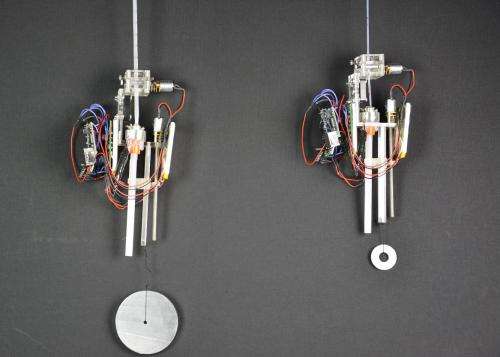Spider-inspired robots carrying payloads descend on their draglines. Credit: Wang, et al. ©2014 IOP Publishing Ltd
(Phys.org) —Inspired by spiders' abilities to produce draglines and use them to move across open space, researchers have designed and built a robot that can do the same. Similar to Spiderman shooting a dragline from his wrist, the robot produces a sticky plastic thread that it attaches to a surface, such as a wall or tree branch. Then the robot descends the dragline, while simultaneously continuing to produce as much line as needed. The mechanism could enable robots to move from any solid surface into open space without the need for flying.
The researchers, Liyu Wang, Utku Culha, and Fumiya Iida, at the Bio-Inspired Robotics Lab at ETH Zurich in Switzerland, have published a paper on the spider-inspired robot in a recent issue of Bioinspiration & Biomimetics.
"The dragline-forming robot is interesting because it implements a new concept: that a robot may accomplish a task by building structures to assist it," Wang told Phys.org. "It is advantageous because the robot can flexibly vary the structure (in this case, the thickness of the dragline) according to environments or tasks that cannot be anticipated."
At first glance, the robot doesn't look much like a spider, since it is about 3 times larger and made of an assortment of metal, wires, and onboard batteries. The source of its dragline material is a stick of thermoplastic adhesive (TPA), which functions similarly to a glue stick in a hot glue gun. When the robot is ready to produce a dragline, the solid TPA stick is pushed through a heating cavity and out of a nozzle. Two wheels located just beyond the nozzle help elongate and guide the dragline in the desired direction. The robot can form draglines with a thickness varying from 1 to 5 mm.
Since the hot TPA dragline is sticky, it can adhere to the solid surface from where the robot starts its journey into open space. Once the dragline is stuck on the surface, the robot can begin descending down the dragline while producing more of it, mimicking the way that spiders fall down their draglines in a controlled way. While spiders use a fourth pair of legs to move down their draglines, the robot relies on its two wheels for locomotion down the dragline.
Demonstration of the dragline-forming robot. Credit: Wang, et al.
In tests, the robot could form and move along its dragline at an average descending speed of 5 cm/min. The robot demonstrated dragline-assisted locomotion for distances of up to 82 cm, although there is no limitation to traveling distance unless the dragline material is used up. The researchers note that the TPA dragline material is potentially reusable, although this ability would require additional onboard mechanisms to retrieve and reuse the material.
In the future, the researchers plan to extend the robot's abilities to enable it to form multiple draglines in both vertical and horizontal directions, eventually forming grids that partially mimic a real spider web. In order to form dragline grids, the robot would need gecko-inspired adhesive legs instead of wheels so that it could easily move between draglines and solid surfaces.
Robots that form their own draglines for locomotion could have a wide variety of applications, particularly in unanticipated environments such as hazard removal and extraterrestrial exploration, among other uses. Although there are other mechanisms that allow robots to cross open space, such as flying or using existing cables, these options have their own sets of challenges such as the payload factor. In some situations, a spider-inspired robot may offer a less complex and more robust alternative.
More information: Liyu Wang, et al. "A dragline-forming mobile robot inspired by spiders." Bioinspir. Biomim. 9 (2014) 016006 (10pp). DOI: 10.1088/1748-3182/9/1/016006
Journal information: Bioinspiration and Biomimetics
© 2014 Phys.org. All rights reserved.























